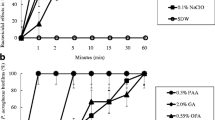Abstract
As part of a programme to establish the relative merits of antiseptics that are used as bladder instillations to control urinary tract infections in patients with indwelling catheters, the activity of five such formulations were tested against dense (109 cfu/cm2) mixed biofilms composed ofCitrobacter diversus, Pseudomonas aeruginosa andEnterococcus faecalis growing on silicone discs. All three species were resistant to chlorhexidine (200 mg/l) and povidone-iodine (1 % v/v) in the biofilm mode of growth, whereas these agents rapidly eliminated viable cells from urine suspensions of the mixed community. Lactic acid (1 % v/v) produced a 1 log reduction of the biofilm population within 30 min of exposure. The mandelic acid (1 % w/v) and mandelic acid (0.5 % w/v)/lactic acid (0.5 % v/v) mixture proved to be the most effective in eliminating the biofilm organisms. It is suggested that these latter solutions should now be tested for efficacy in bladder washouts against urinary tract infections in catheterized patients.
Similar content being viewed by others
References
Ladd TI, Schmiel D, Nickel JC: Rapid method for detection of adherent bacteria on Foley urinary catheters. Journal of Clinical Microbiology 1985, 21: 1004–1006.
Nickel JC, Gristina AG, Costerton JW: Electron microscope study of an infected Foley catheter. Canadian Journal of Surgery 1985, 28: 50–52.
Ramsay JWA, Garnham AJ, Mulhall AB, Crow RA, Bryan JM, Eardley I, Vale JA, Whitfield HN: Biofilms, bacteria and bladder catheters. British Journal of Urology 1989, 64: 395–398.
Costerton JW, Cheng KJ, Geesey GG, Ladd TI, Nickel JC, Dasgupta M, Marrie TJ: Bacterial biofilms in nature and disease. Annual Reviews of Microbiology 1987, 41: 435–464.
Nichols WW: Susceptibility of biofilms to toxic compounds. In: Characklis WG, Wilderer PA (ed): Structure and function of biofilms. John Wiley, Chichester, 1989, p. 321–331.
Costerton JW: The aetiology and persistence of cryptic bacterial infections: a hypothesis. Reviews of Infectious Disease 1984, Supplement 3: 608–612.
Clayton CL, Chawla JC, Stickler DJ: Some observations on urinary tract infections in patients undergoing long-term bladder catheterization. Journal of Hospital Infection 1982, 3: 39–47.
Guttman L: Spinal cord injuries. Comprehensive management and research. Blackwell Scientific Publications, Oxford, 1973, p. 230.
Kirk D, Dunn M, Bullock DW, Mitchell JP, Hobbs SJF: Hibitane bladder irrigation in the prevention of catheter-associated urinary infection. British Journal of Urology 1979, 51: 528–531.
Ball AJ, Carr TW, Gillespie WA, Kelly M, Simpson RA, Smith PJB: Bladder irrigation with chlorhexidine for the prevention of urinary infection after transurethral operations: a prospective controlled study. Journal of Urology 1987, 138: 491–494.
Brocklehurst JC, Brocklehurst S: The management of indwelling catheters. British Journal of Urology 1978, 50: 102–105.
Stickler DJ, Plant S, Bunni NH, Chawla JC: Some observations on the activity of three antiseptics used as bladder irrigants in the treatment of urinary tract infection in patients with indwelling catheters. Paraplegia 1981, 19: 325–333.
Davies AJ, Desai HN, Turton S, Dyas A: Does instillation of chlorhexidine into the bladder of catheterized geriatric patients help reduce bacteriuria? Journal of Hospital Infection 1987, 9: 72–75.
Stickler DJ, Clayton CL, Chawla JC: The resistance of urinary tract pathogens to chlorhexidine bladder washouts. Journal of Hospital Infection 1987, 10: 219–228.
Stickler DJ, Clayton CL, Chawla JC: Assessment of antiseptic bladder washout procedures using a physical model of the catheterized bladder. British Journal of Urology 1987, 60: 413–418.
Stickler D, Dolman J, Rolfe S, Chawla J: Activity of antiseptics againstEscherichia coli growing as biofilms on silicone surfaces. European Journal of Clinical Microbiology and Infectious Diseases 1989, 8: 974–978.
Stickler D, Dolman J, Rolfe S, Chawla J: Activity of some antiseptics against urinary tract pathogens growing as biofilms on silicone surfaces. European Journal of Clinical Microbiology and Infectious Diseases 1991, 10: 410–415.
Prosser BTL, Taylor D, Dix BA, Cleeland R: Method of evaluating effects of antibiotics on bacterial biofilm. Antimicrobial Agents and Chemotherapy 1987, 31: 1502–1506.
Nickel JC, Ruseska I, Wright JB, Costerton JW: Tobramycin resistance ofPseudomonas aeruginosa cells growing as a biofilm on urinary catheter material. Antimicrobial Agents and Chemotherapy 1985, 27: 619–624.
Author information
Authors and Affiliations
Additional information
Corrected version of a paper published in a previous issue of this journal.
Rights and permissions
About this article
Cite this article
Stickler, D., Hewett, P. Activity of antiseptics against biofilms of mixed bacterial species growing on silicone surfaces. Eur. J. Clin. Microbiol. Infect. Dis. 10, 416–421 (1991). https://doi.org/10.1007/BF01968021
Issue Date:
DOI: https://doi.org/10.1007/BF01968021




